Monitoring and Modeling of Spatiotemporal Urban Expansion and Land-Use/Land-Cover Change Using Integrated Markov Chain Cellular Automata Model
Abstract
:1. Introduction
2. Materials and Methodology
2.1. Study Area
2.2. Satellite Data and Pre-Processing
2.3. Extraction of LULC Maps and Analysis
2.4. Quantification of LULC Based Transition Analysis
2.5. Measuring Urban Expansion Rate and Analysis of Urban Extent
2.6. Simulation of LULC Change
2.6.1. CA–Markov Modeling
| 0 | 0 | 1 | 0 | 0 |
| 0 | 1 | 1 | 1 | 0 |
| 1 | 1 | 1 | 1 | 1 |
| 0 | 1 | 1 | 1 | 0 |
| 0 | 0 | 1 | 0 | 0 |
2.6.2. Generating Transition Potential Maps
2.6.3. Evaluation of Land-Cover Modeling
3. Results and Discussion
3.1. LULC Dynamics
3.2. Spatial Transitions
3.3. Urban Expansion
3.4. Urban Extent from City Center Outwards
3.5. Markov Model
3.5.1. Analysis of Transition Matrix
3.5.2. Land-Cover Modeling and Validation
3.5.3. Analysis of Simulation Results
4. Conclusions
Acknowledgments
Author Contributions
Conflicts of Interest
References
- Moghadam, H.S.; Helbich, M. Spatiotemporal urbanization processes in the megacity of Mumbai India: A Markov chains-cellular automata urban growth model. Appl. Geogr. 2013, 40, 140–149. [Google Scholar] [CrossRef]
- Ramankutty, N.; Foley, J.A. Estimating historical changes in global land cover: Croplands from 1700 to 1992. Glob. Biogeochem. Cycles 1999, 13, 997–1027. [Google Scholar] [CrossRef]
- Tan, M.; Li, X.; Xie, H.; Lu, C. Urban land expansion and arable land loss in China, A case study of Beijing-Tianjin-Hebei region. Land Use Policy 2005, 22, 187–196. [Google Scholar] [CrossRef]
- Chen, J. Rapid urbanization in China: A real challenge to soil protection and food security. Catena 2007, 69, 1–15. [Google Scholar] [CrossRef]
- Xu, Y.; Chan, E.H.W.; Yung, E.H.K. Overwhelming Farmland Conversion for Urban Development in Transitional China: Case Study of Shanghai. J. Urban Plan. Dev. 2014. [Google Scholar] [CrossRef]
- Thapa, R.B. Spatial Process of Urbanization in Kathmandu Valley, Nepal. Ph.D. Thesis, The University of Tsukuba, Tsukuba, Japan, 2009. [Google Scholar]
- Hyandye, C. Gis and logit regression model applications in land use/land cover change and distribution in usangu catchment. Am. J. Remote Sens. 2015, 3, 6–16. [Google Scholar] [CrossRef]
- UN-Habitat (United Nations Human Settlements Programme) and UN-ESCAP (United Nations Economic and Social Commission for Asia and the Pacific). The State of Asian and Pacific Cities 2015, Urban Transformations Shifting from Quantity to Quality. 2015. Available online: https://unhabitat.org/books/the-state-of-asian-and-pacific-cities-2015/ (accessed on 21 November 2016).
- Wu, W.J.; Zhao, S.Q.; Zhu, C.J. A comparative study of urban expansion in Beijing, Tianjin and Shijiazhuang over the past three decades. Landsc. Urban Plan. 2014, 134, 93–106. [Google Scholar] [CrossRef]
- Zhang, Z.; Li, N.; Wang, X.; Liu, F.; Yang, L. A Comparative Study of Urban Expansion in Beijing, Tianjin and Tangshan from the 1970s to 2013. Remote Sens. 2016, 8, 1–22. [Google Scholar] [CrossRef]
- Wu, J.; Jenerette, G.D.; Buyantuyev, A.; Redman, C.L. Quantifying spatiotemporal patterns of urbanization: The case of the two fastest growing metropolitan regions in the United States. J. Ecol. Complex. 2011, 8, 1–8. [Google Scholar] [CrossRef]
- United Nation Department of Economicand Social Affairs, P.D. World Population Prospects the 2017 Revision, Key Findings; United Nations: New York, NY, USA, 2017. [Google Scholar]
- United Nations Department of Economic and Social Affairs, P.D. World Urbanization Prospects the 2014 Revision, Highlights; United Nations: New York, NY, USA, 2014. [Google Scholar]
- Dewan, A.M.; Yamaguchi, Y. Land use and land cover change in Greater Dhaka, Bangladesh: Using remote sensing to promote sustainable urbanization. Appl. Geogr. 2009, 29, 390–401. [Google Scholar] [CrossRef]
- Dewan, A.M.; Yamaguchi, Y.; Rahman, M.Z. Dynamics of land use/cover changes and the analysis of landscape fragmentation in Dhaka Metropolitan, Bangladesh. GeoJournal 2012, 77, 315–330. [Google Scholar] [CrossRef]
- Guan, D.; Li, H.; Inohae, T.; Su, W.; Nagaie, T.; Hokao, K. Modeling urban land use change by the integration of cellular automaton and Markov model. Ecol. Model. 2011, 222, 3761–3772. [Google Scholar] [CrossRef]
- Su, S.; Xiao, R.; Jiang, Z.; Zhang, Y. Characterizing landscape pattern and ecosystem service value changes for urbanization impacts at an eco-regional scale. Appl. Geogr. 2012, 34, 295–305. [Google Scholar] [CrossRef]
- Ouyang, Z.; Fan, P.; Chen, J. Urban Built-up Areas in Transitional Economies of Southeast Asia: Spatial Extent and Dynamics. Remote Sens. 2016, 8, 1–19. [Google Scholar] [CrossRef]
- Thapa, R.B.; Murayama, Y. Drivers of urban growth in the Kathmandu valley, Nepal: Examining the efficacy of the analytic hierarchy process. Appl. Geogr. 2010, 30, 70–83. [Google Scholar] [CrossRef]
- CBS (Central Bureau of Statistics). Population Monograph of Nepal 2014. Available online: http://cbs.gov.np/population/populationmonographnepa_2014 (accessed on 29 January 2017).
- Rimal, B.; Zhang, L.; Fu, D.; Kunwar, R.; Zhai, Y. Monitoring urban growth and the nepal earthquake 2015 for sustainability of kathmandu valley, Nepal. Land 2017, 6, 1–23. [Google Scholar] [CrossRef]
- Li, X.; Yeh, A.G. Modelling sustainable urban development by the integration of constrained cellular automata and GIS. Int. J. Geogr. Inf. Sci. 2000, 14, 131–152. [Google Scholar] [CrossRef]
- Schneider, A. Monitoring land cover change in urban and peri-urban areas using dense time stacks of Landsat satellite data and a data mining approach. Remote Sens. Environ. 2012, 124, 689–704. [Google Scholar] [CrossRef]
- Jensen, J.R. Introductory Digital Processing: A Remote Sensing Perspective; Prentice-Hall: Upper Saddle River, NJ, USA, 1996. [Google Scholar]
- Corner, R.J.; Dewan, A.M.; Chakma, S. Monitoring and Prediction of Land-Use and Land-Cover (LULC) Change. In Dhaka Megacity, Geospatial Perspectives on Urbanization, Environment and Health; Springer Geography: Dordrecht, The Netherlands, 2013; pp. 75–97. Available online: http://www.springer.com/gp/book/9789400767348 (accessed on 17 January 2017).
- Hu, Z. Modeling urban growth in Atlanta using logistic regression. Comput. Environ. Urban Syst. 2007, 31, 667–688. [Google Scholar] [CrossRef]
- Eastman, J.R.; Solo’rzano, L.A.; Fossen, M.E.V. Transition Potential Modeling for Land Cover Change. In GIS Spatial Analysis and Modeling, 1st ed.; ESRI Press: Redlands, CA, USA, 2005; pp. 357–385. ISBN 978-1-58948-130-5. [Google Scholar]
- Yu, W.; Zhang, S.; Wu, C.; Liu, W.; Na, X. Analyzing and modeling land use land cover change (LUCC) in the Daqing City, China. Appl. Geogr. 2011, 31, 600–608. [Google Scholar] [CrossRef]
- Keshtkar, H.; Voigt, W. A spatiotemporal analysis of landscape change using integrated Markov chain cellular automata model. Model. Earth Syst. Environ. 2016, 2, 1–13. [Google Scholar] [CrossRef]
- Weng, Q. Land use change analysis in the Zhujiang Delta of China using satellite remote sensing, GIS and stochastic modeling. J. Environ. Manag. 2002, 64, 273–284. [Google Scholar] [CrossRef]
- Arsanjani, J.J.; Helbich, M.; Kainz, W.; Boloorani, A.D. Integration of logistic regression, Markov chain and cellular automata models to simulate urban expansion. Int. J. Appl. Earth Obs. Geoinf. 2013, 21, 265–275. [Google Scholar] [CrossRef]
- Dewan, A.M.; Islam, M.M.; Kumamoto, T.; Nishigaki, M. Evaluating Flood Hazard for Land-Use Planning in Greater Dhaka of Bangladesh Using Remote Sensing and GIS Techniques. Water Resour. Manag. 2007, 21, 1601–1612. [Google Scholar] [CrossRef]
- Dewan, A.M.; Kabir, M.H.; Nahar, K.; Rahman, M.Z. Urbanization and Environmental degradation in Dhaka Metropolitan Area of Bangladesh. Int. J. Environ. Sustain. Dev. 2012, 11, 118–147. [Google Scholar] [CrossRef]
- Byomkesh, T.; Nakagoshi, N.; Dewan, A.M. Urbanization and green space dynamics in Greater Dhaka, Bangladesh. Landsc. Ecol. Eng. 2012, 8, 45–58. [Google Scholar] [CrossRef]
- Rahaman, M.T. Detection of Land Use/Land Cover Changes and Urban Sprawl in Al-Khobar, Saudi Arabia: An Analysis of Multi-Temporal Remote Sensing Data. ISPRS Int. J. Geo-Inf. 2016, 5, 1–17. [Google Scholar]
- Cheng, J. Modelling Spatial and Temporal Urban Growth. Ph.D. Thesis, Faculty of Geo-Information Science and Earth Observation of Utrecht University, Enschede, The Netherlands, 2003, unpublished. [Google Scholar]
- Feng, Y.; Lu, D.; Moran, E.; Dutra, L.; Calvi, M.; de Oliveira, M. Examining spatial distribution and dynamic change of urban land covers in the brazilian amazon using multitemporal multisensor high spatial resolution satellite imagery. Remote Sens. 2017, 9, 1–20. [Google Scholar] [CrossRef]
- DDC (District Development Committee), Government of Nepal. District Profile; DDC: Jhapa, Nepal, 2014.
- USGS (United States Geological Survey) Earth Explorer, Landsat Data Archive. 2016. Available online: https://earthexplorer.usgs.gov/ (accessed on 6 September 2017).
- Rozenstein, O.; Qin, Z.; Derimian, Y.; Karnieli, A. Derivation of land surface temperature for Landsat-8 TIRS using a split window algorithm. Sensors 2014, 14, 5768–5780. [Google Scholar] [CrossRef] [PubMed]
- Zhu, Z.; Fu, Y.; Woodcock, C.E.; Olofsson, P.; Vogelmann, J.E.; Holden, C.; Wang, M.; Dai, S.; Yu, Y. Including land cover change in analysis of greenness trends using all available Landsat 5, 7, and 8 images: A case study from Guangzhou, China (2000–2014). Remote Sens Environ. 2016, 185, 243–257. [Google Scholar] [CrossRef]
- Google Earth Satellite Imagery of Jhapa (26°21′43′′–26°48′5′′ North to 87°38′8′′ to 88°12′00′′ East), Nepal, Images. Available online: http://earth.google.com (accessed on 8 September 2017).
- GoN (Government of Nepal), Ministry of Land Reform and Management: Survey Department, Topographic Survey Branch, Kathmandu. 1996. Available online: http://molrm.gov.np/ (accessed on 10 September 2017).
- ENVI Software, Version 4.8., ITT Visual Information Solutions, Boulder, USA. 2010. Available online: https://www.scientificcomputing.com/company-profiles/itt-visual-information-solutions (accessed on 10 September 2017).
- Zhou, Q.; Li, B.; Kurban, A. Trajectory analysis of land cover change in arid environment of China. Int. J. Remote Sens. 2008, 29, 1093–1107. [Google Scholar] [CrossRef]
- Yin, J.; Yin, Z.; Zhong, H.; Xu, S.; Hu, X.; Wang, J.; Wu, J. Monitoring urban expansion and land use/land cover changes of Shanghai metropolitan area during the transitional economy (1979–2009) in China. Environ. Monit. Assess. 2011, 177, 609–621. [Google Scholar] [CrossRef] [PubMed]
- Zhao, P.; Lu, D.; Wang, G.; Wu, C.; Huang, Y.; Yu, S. Examining Spectral Reflectance Saturation in Landsat Imagery and Corresponding Solutions to Improve Forest Aboveground Biomass Estimation. Remote Sens. 2016, 8, 1–26. [Google Scholar] [CrossRef]
- Alqurashi, A.F.; Kumar, L.; Sinha, P. Urban Land Cover Change Modelling Using Time-Series Satellite Images: A Case Study of Urban Growth in Five Cities of Saudi Arabia. Remote Sens. 2016, 8, 1–24. [Google Scholar] [CrossRef]
- Anderson, J.R.; Hardy, E.E.; Roach, J.T.; Witmer, R.E. A Land Use and Land Cover Classification System for Use with Remote Sensor Data; United States Government Printing Office: Washington, DC, USA, 1976.
- Clark Labs. TerrSet Software; Clark Labs: Worcester, MA, USA, 2016. [Google Scholar]
- Xiao, P.; Wang, X.; Feng, X.; Zhang, X.; Yang, Y. Detecting China’s Urban expansion over the Past Three Decades Using Nighttime Light data. IEEE Appl. Earth Obs. Remote Sens. 2014, 7, 4095–4106. [Google Scholar] [CrossRef]
- Wu, H.; Sun, Y.; Shi, W.; Chen, X.; Fu, D. Examining the Satellite-Detected Urban Land Use Spatial Patterns Using Multidimensional Fractal Dimension Indices. Remote Sens. 2013, 5, 51–72. [Google Scholar] [CrossRef]
- Jiao, L. Urban land density function: A new method to characterize urban expansion. Landsc. Urban Plan. 2015, 139, 26–39. [Google Scholar] [CrossRef]
- Shi, M.; Xie, Y.; Cao, Q. Spatiotemporal Change in Rural settlement land and Rural Population in Middle basin of the Heihe River China. Sustainability 2016, 8, 614. [Google Scholar] [CrossRef]
- Dewan, A.M.; Corner, R.J. Spatiotemporal Analysis of Urban Growth, Sprawl and Structure. In Dhaka Megacity, Geospatial Perspectives on Urbanization, Environment and Health; Springer Geography: Dordrecht, The Netherlands, 2013; pp. 99–121. Available online: http://www.springer.com/gp/book/9789400767348 (accessed on 17 January 2017).
- Eyoh, A.; Olayinka, D.N.; Nwilo, P.; Okwuashi, O.; Isong, M.; Udoudo, D. Modelling and Predicting Future Urban Expansion of Lagos, Nigeria from Remote Sensing Data Using Logistic Regression and GIS. Int. J. Appl. Sci. Technol. 2012, 2, 116–124. [Google Scholar]
- Muller, M.R.; Middleton, J. A Markov Model of land use change dynamics in the Niagara Region, Ontario, Canada. Landsc. Ecol. 1994, 9, 151–157. [Google Scholar]
- Sante, I.; Garcia, A.M.; Miranda, D.; Crecente, R. Cellular automata models for the simulation of real-world urban processes: A review and analysis. Landsc. Urban Plan. 2010, 96, 108–122. [Google Scholar] [CrossRef]
- Ward, D.P.; Murray, A.; Phinn, S.R. A stochastically constrained cellular model of urban growth. Comput. Environ. Urban Syst. 2000, 24, 539–558. [Google Scholar] [CrossRef]
- Keshtkar, H.; Voigt, W. Potential impacts of climate and landscape fragmentation changes on plant distributions: Coupling multi-temporal satellite imagery with GIS-based cellular automata model. Ecol. Inform. 2016, 32, 145–155. [Google Scholar] [CrossRef]
- Araya, Y.H.; Cabral, P. Analysis and Modeling of Urban Land Cover Change in Setúbal and Sesimbra, Portugal. Remote Sens. 2010, 2, 1549–1563. [Google Scholar] [CrossRef]
- Ranagalage, M.; Eastoque, R.C.; Murayama, Y. An Urban Heat Island Study of the Colombo Metropolitan Area, Sri Lanka, Based on Landsat Data (1997–2017). ISPRS Int. J. Geo-Inf. 2017, 6, 1–17. [Google Scholar] [CrossRef]
- Ministry of Home Affairs (MoHA). Nepal Disaster Report; Ministry of Home Affairs. Government of Nepal: Kathmandu, Nepal, 2017. Available online: http://drrportal.gov.np (accessed on 6 September 2017).
- Li, X.; Zhou, W.; Ouyang, Z. Forty years of urban expansion in Beijing: What is the relative importance of physical, socioeconomic, and neighborhood factors? Appl. Geogr. 2013, 38, 1–10. [Google Scholar] [CrossRef]
- Pradhan, P.; Perera, R. Urban growth and its impact on the livelihoods of Kathmandu valley, Nepal Urban Management Programme (UMP). Asia Occas. Pap. 2005, 63, 1–40. [Google Scholar]
- Rimal, B. Urban Development and Land Use Change of Main Nepalese Cities. Ph.D. Thesis, the Faculty of Earth Science and Environmental Management, University of Wroclaw, Wrocław, Poland, 2011, unpublished. [Google Scholar]
- Muzzini, E.; Aparicio, G. Urban Growth and Spatial Transition in Nepal, an Initial Assessment; The World Bank: Washington, DC, USA, 2013. [Google Scholar]
- Rimal, B. Urbanization and the decline of agricultural land in pokhara sub-metropolitan city, Nepal. J. Agric. Sci. 2012, 5, 54–56. [Google Scholar] [CrossRef]
- Rimal, B.; Baral, H.; Stork, N.E.; Paudyal, K.; Rijal, S. Growing City and Rapid Land Use Transition: Assessing Multiple Hazards and Risk in the Pokhara Valley Nepal. Land 2015, 4, 957–978. [Google Scholar] [CrossRef]
- Lambin, E.F.; Meyfroidt, P. Global land use change, economic globalization, and the looming land scarcity. Proc. Natl. Acad. Sci. USA 2011, 108, 3465–3472. [Google Scholar] [CrossRef] [PubMed]
- Rey Benayas, J.M.; Martins, A.; Nicolau, J.M.; Schulz, J. Abandonment of agricultural land: An overview of drivers and consequences. Perspect. Agric. Vet. Sci. Nutr. Nat. 2007, 2, 1–14. [Google Scholar] [CrossRef]
- Wang, C.; Gao, Q.; Wang, X.; Yu, M. Decadal Trend in Agricultural Abandonment and Woodland Expansion in an Agro-Pastoral Transition Band in Northern China. PLoS ONE 2015, 10, e0142113. [Google Scholar] [CrossRef] [PubMed]
- Wang, C.; Gao, Q.; Wang, X.; Yu, M. Spatially differentiated trends in urbanization, agricultural land abandonment and reclamation, and woodland recovery in northern China. Sci. Rep. 2016, 6, 37658. [Google Scholar] [CrossRef] [PubMed]
- Poudel, B.; Pandit, J.; Reed, B. Fragmentation and Conversion of Agriculture Land in Nepal and Land Use Policy 2012. MPRA: Munich, Germany, 2013. Available online: http://mpra.ub.uni-muenchen.de/58880/ (accessed on 6 September 2017).
- Meier, E.S.; Lischke, H.; Schmatz, D.R.; Zimmermann, N.E. Climate, competition and connectivity affect future migration and ranges of European trees. Glob. Ecol. Biogeogr. 2012, 21, 164–178. [Google Scholar] [CrossRef]
- Engler, R.; Randin, C.F.; Thuiller, W.; Dullinger, S.; Zimmermann, N.E.; Araújo, M.B.; Pearman, P.B.; Le Lay, G.; Piedallu, C.; Albert, C.H.; et al. 21st century climate change threatens mountain flora unequally across Europe. Glob. Chang. Biol. 2011, 17, 2330–2341. [Google Scholar] [CrossRef]
- NLUP (National Land Use Project). The National Land Use Policy; Ministry of Land Reform and Management: Kathmandu, Nepal, 2015.
- MoUD (Ministry of Urban Development). National Urban Development Strategy (NUDS) 2015. Available online: http://moud.gov.np/wp-content/uploads/2016/08/NUDS-2015-final-draft.pdf (accessed on 1 January 2017).
- Solecki, W.D.; Rosenzweig, C.; Parshall, L.; Pope, G.; Clark, M.; Cox, J.; Wiencke, M. Mitigation of the heat island effect in urban New Jersey. Glob. Environ. Chang. Part B: Environ. Hazards 2005, 6, 39–49. [Google Scholar] [CrossRef]
- Changnon, S.A.; Kunkel, K.E.; Reinke, B.C. Impacts and responses to the 1995 heat wave: A call to action. Bull. Am. Meteorol. Soc. 1996, 77, 1497–1506. [Google Scholar] [CrossRef]
- Albers, R.A.W.; Bosch, P.R.; Blocken, B.; Van Den Dobbelsteen, A.A.J.F.; Van Hove, L.W.A.; Spit, T.J.M.; Rovers, V. Overview of challenges and achievements in the Climate Adaptation of Cities and in the Climate Proof Cities program. Build. Environ. 2015, 83, 1–10. [Google Scholar] [CrossRef]
- California’s Advanced Clean Cars Program. Advanced Clean Cars. N.p., n.d. Web. 6 April 2014. Available online: http://www.arb.ca.gov/msprog/consumer_info/advanced_clean_cars/consumer_acc.htm (accessed on 6 September 2017).
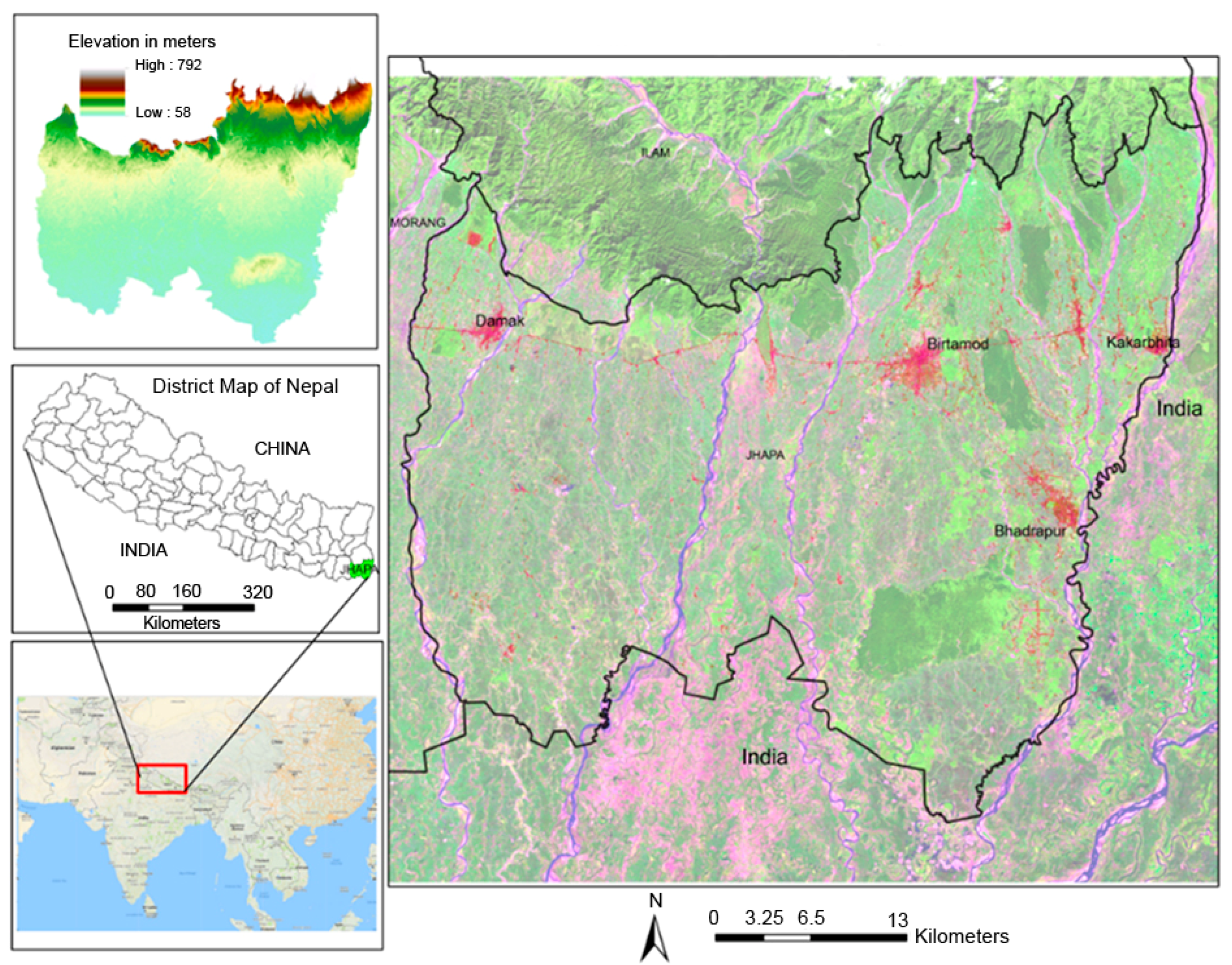
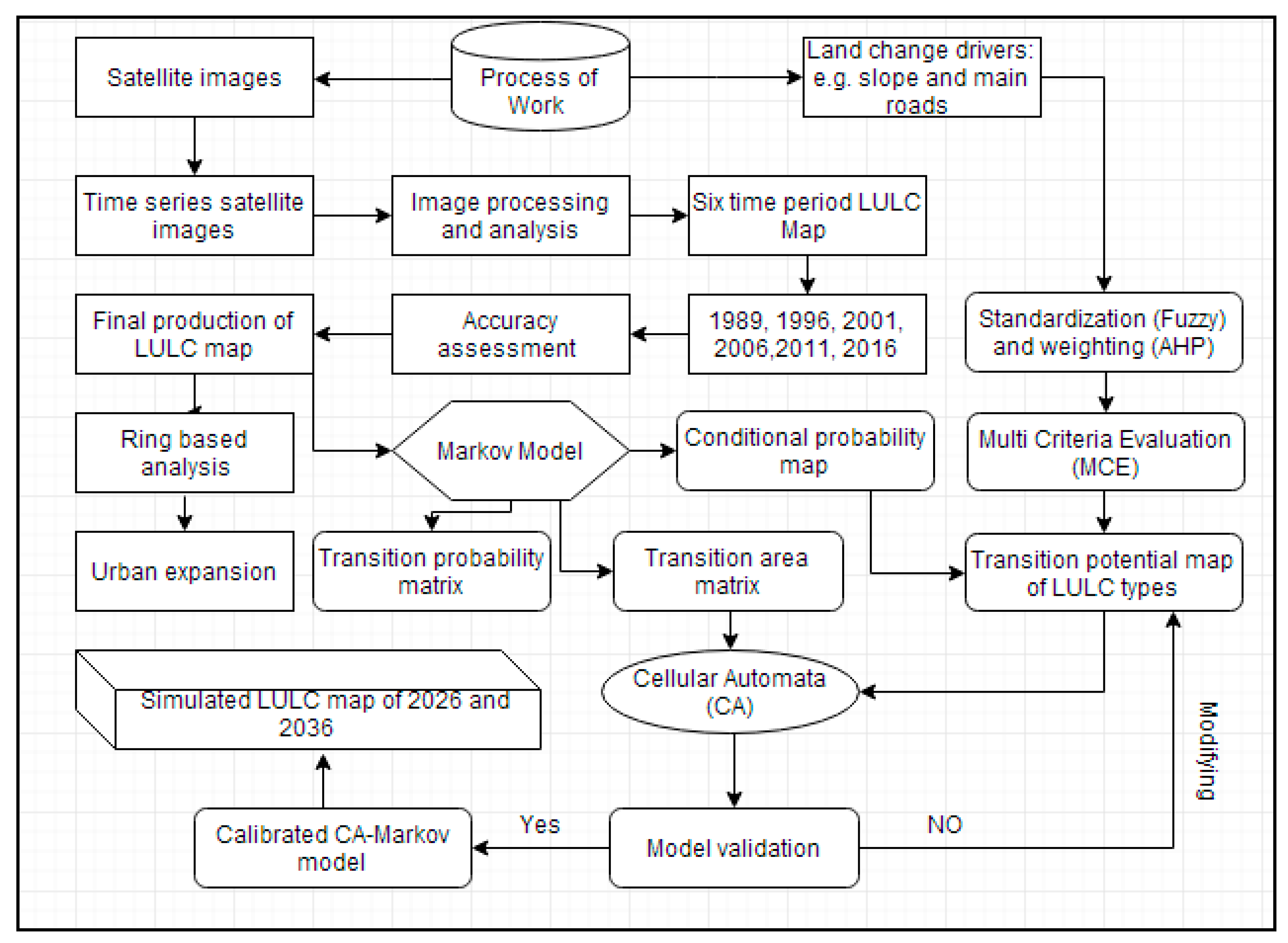
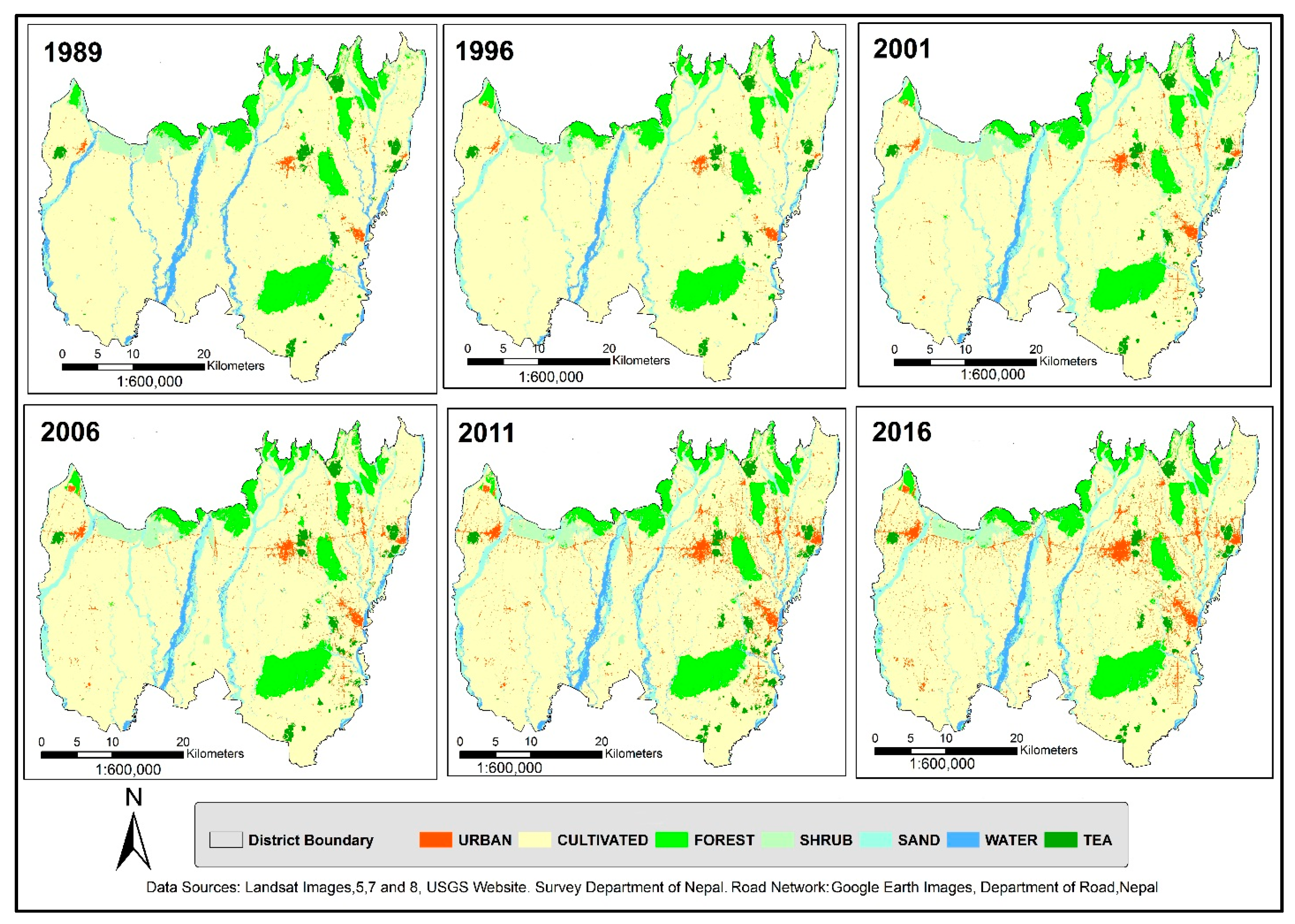
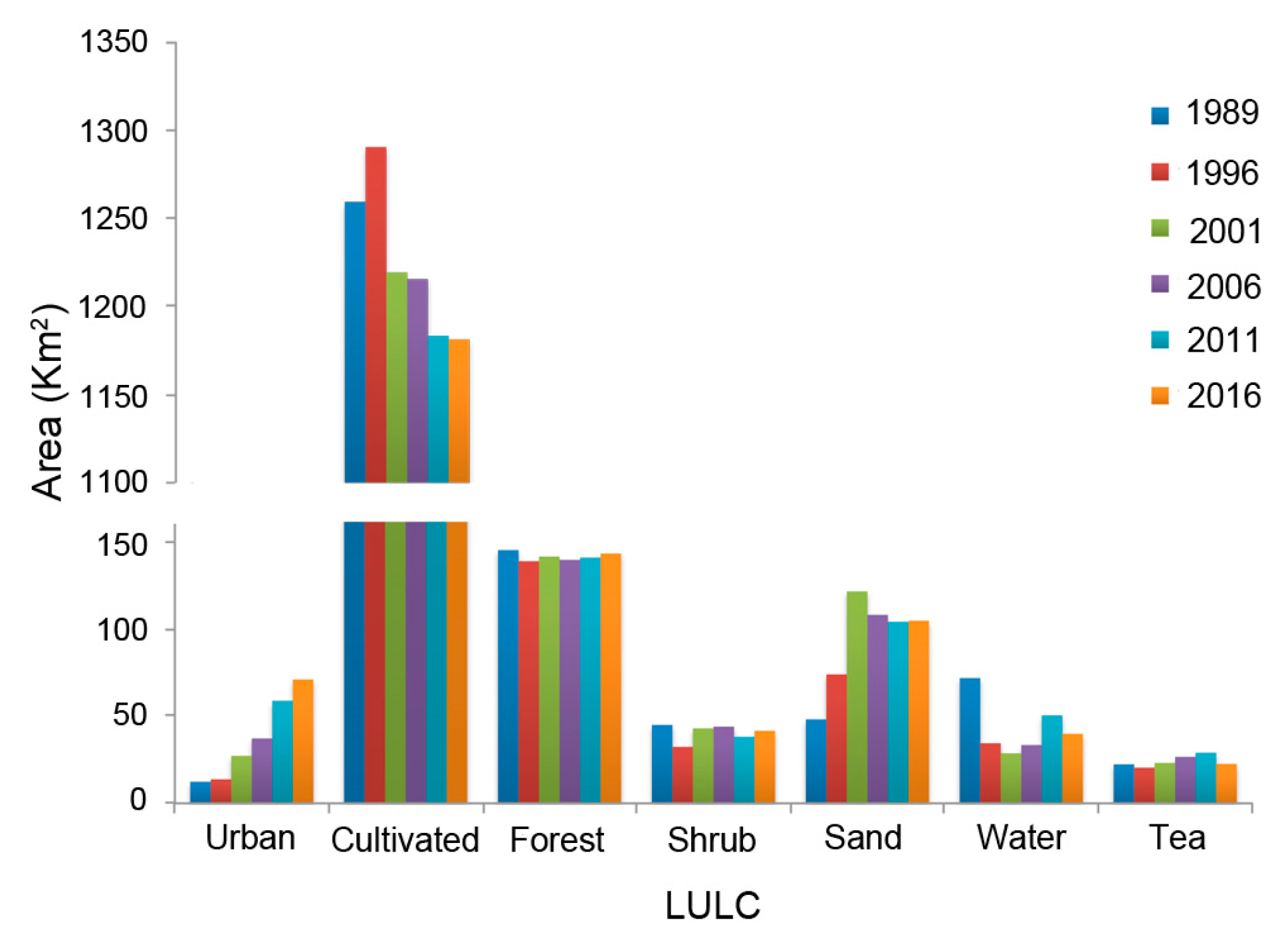

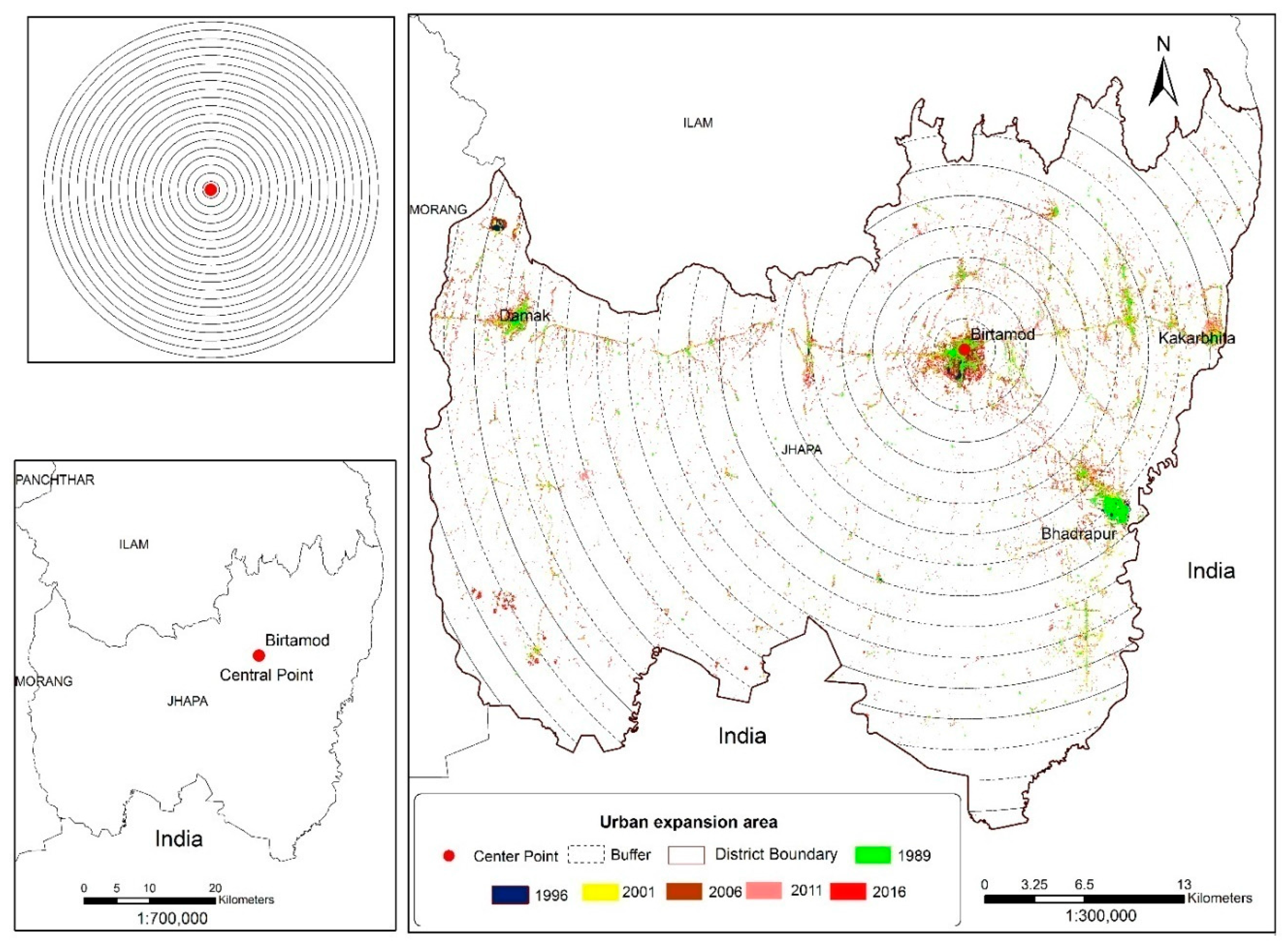
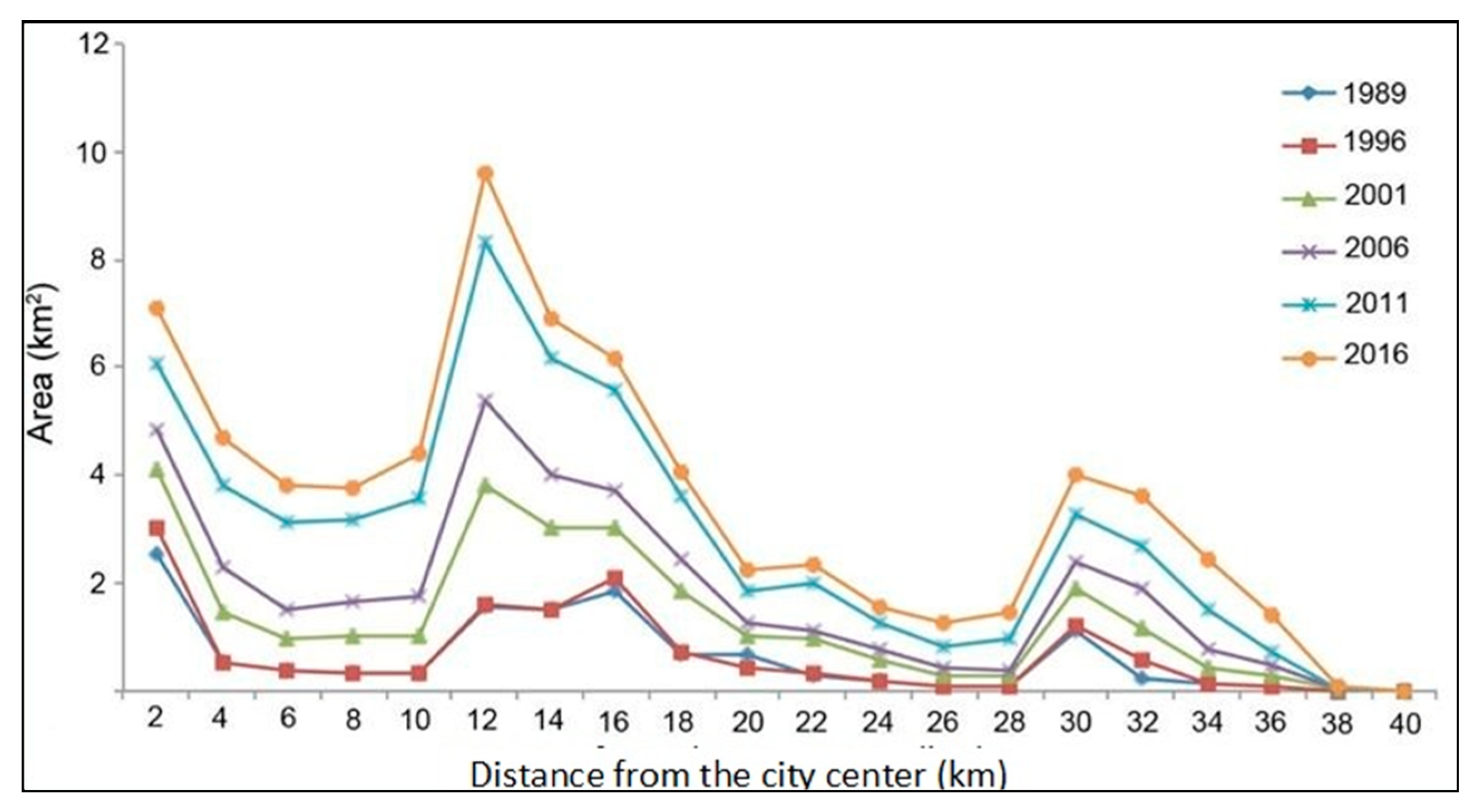
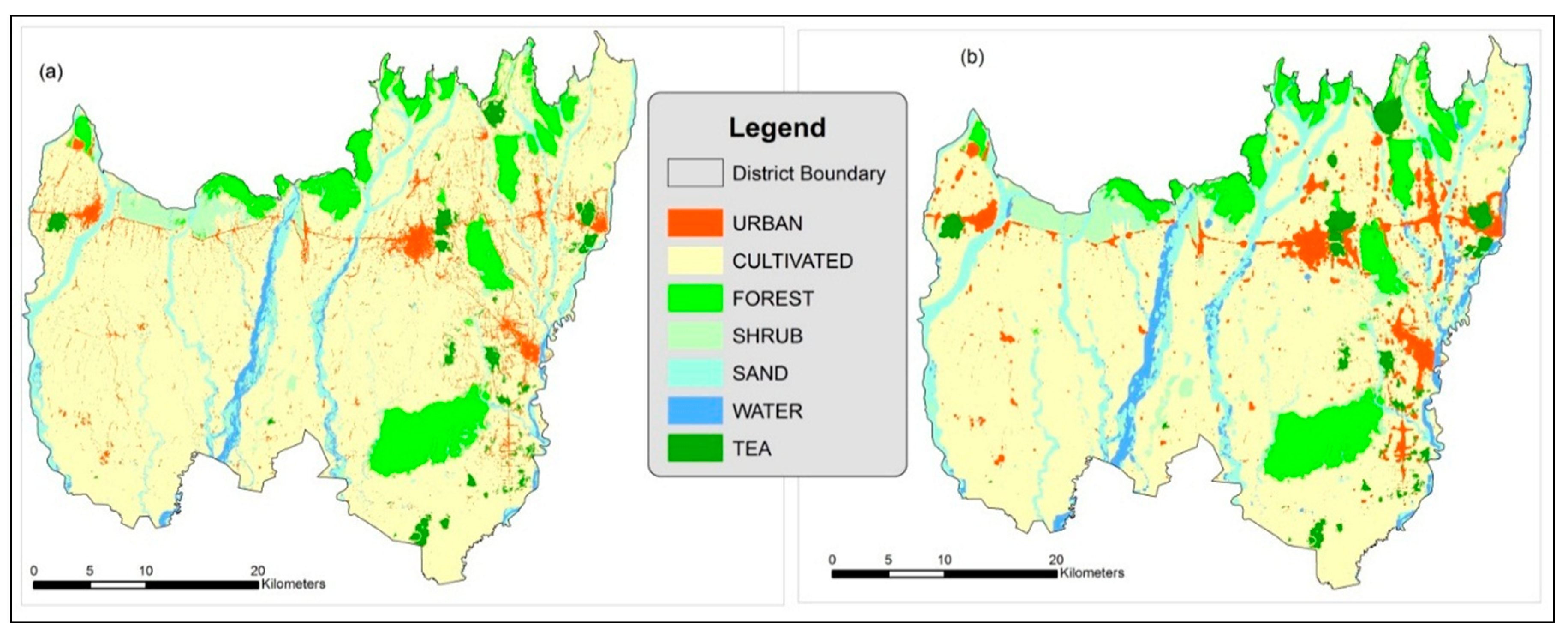
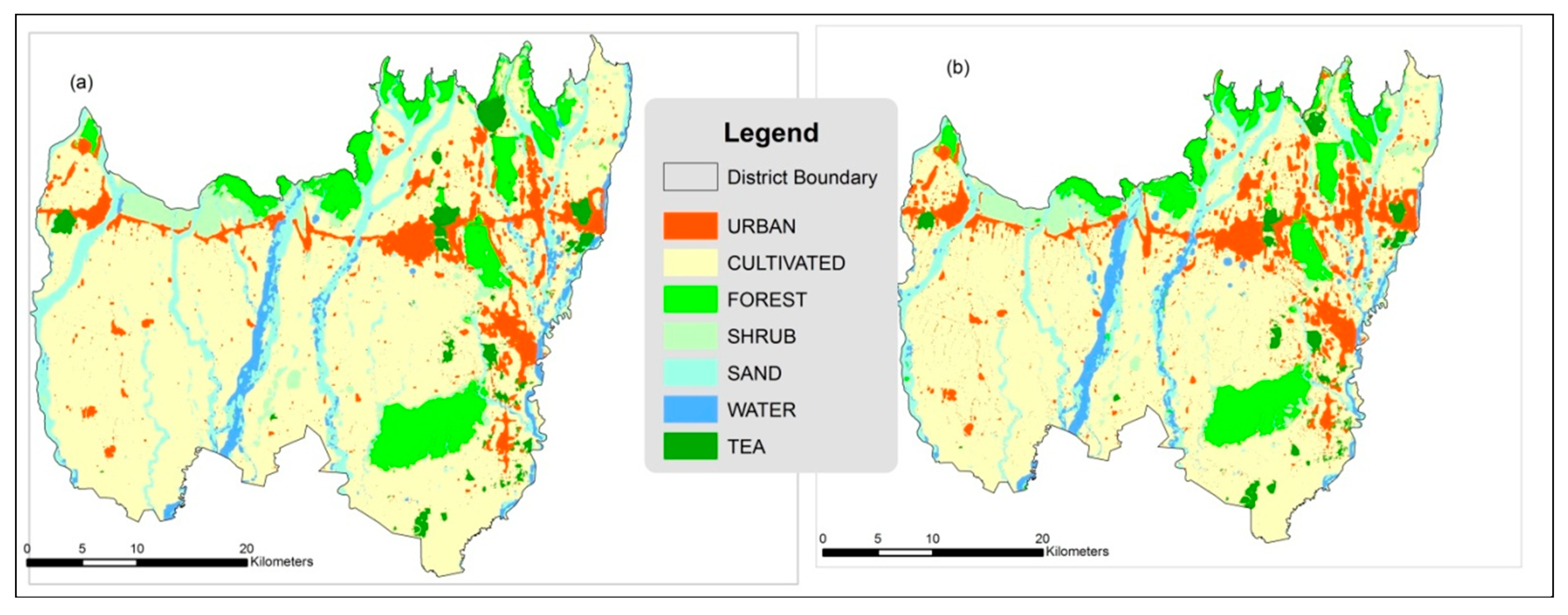
| Land-Cover Types | Description |
|---|---|
| Urban (Built-up) | Urban and rural settlements, commercial areas, industrial areas, construction areas, traffic, airports, public service areas (e.g., school, college, hospital) |
| Cultivated land | wet and dry crop lands, orchards |
| Forest | Evergreen broad leaf forest, deciduous forest, scattered forest, low density sparse forest, degraded forest |
| Shrub | Mix of trees (<5 m tall) and other natural covers |
| Sand | Sand area, other open field area, river bank |
| Water | River, lake/pond, canal, reservoir |
| Tea | Tea plantations |
| Factors | Functions | Control Points | Weights |
|---|---|---|---|
| Distance from main roads | J-shaped | 0–500 m highest suitability 500–5000 m decreasing suitability >5000 m no suitability | 0.28 |
| Distance from water bodies | Linear | 0–100 m no suitability 100–7500 m increasing suitability >7500 m highest suitability | 0.15 |
| Distance from built-up areas | Linear | 0–100 m highest suitability 100–5000 km decreasing suitability >5000 km no suitability | 0.38 |
| Slope | Sigmoid | 0% highest suitability 0–15% decreasing suitability >15% no suitability | 0.19 |
| Year | 1989 | 1996 | 2001 | 2006 | 2011 | 2016 | ||||||
|---|---|---|---|---|---|---|---|---|---|---|---|---|
| OA | 80.95% | 85.20% | 82.38% | 85.71% | 84.80% | 86.20% | ||||||
| PA (%) | UA (%) | PA (%) | UA (%) | PA (%) | UA (%) | PA (%) | UA (%) | PA (%) | UA (%) | PA (%) | UA (%) | |
| Built-up | 88.00 | 85.33 | 88.89 | 84.00 | 96.31 | 89.00 | 88.79 | 86.67 | 83.33 | 81.26 | 89.29 | 92.53 |
| Cultivated | 87.10 | 90.00 | 90.32 | 93.33 | 83.87 | 86.67 | 87.10 | 90.00 | 80.65 | 83.33 | 83.87 | 86.67 |
| Forest | 86.21 | 83.33 | 89.29 | 83.33 | 88.89 | 80.00 | 95.59 | 83.33 | 84.38 | 90.00 | 87.50 | 93.44 |
| Shrub | 77.42 | 80.00 | 83.33 | 83.33 | 80.65 | 83.33 | 81.25 | 86.67 | 80.00 | 80.00 | 86.21 | 83.33 |
| Sand | 81.48 | 73.33 | 88.89 | 80.00 | 76.67 | 76.67 | 81.82 | 90.00 | 83.87 | 86.67 | 81.82 | 90.00 |
| Water | 85.15 | 83.33 | 90.00 | 91.00 | 89.66 | 86.67 | 88.46 | 76.67 | 96.43 | 90.00 | 92.31 | 80.00 |
| Tea | 95.15 | 83.33 | 95.30 | 86.67 | 100.00 | 83.33 | 95.30 | 86.67 | 95.15 | 83.33 | 92.86 | 86.67 |
| LULC | 1989 | 1996 | 2001 | 2006 | 2011 | 2016 |
|---|---|---|---|---|---|---|
| Urban | 12.35 | 13.71 | 27.12 | 37.09 | 58.65 | 70.91 |
| Cultivated | 1259.34 | 1290.34 | 1219.27 | 1215.43 | 1183.25 | 1181.27 |
| Forest | 144.95 | 138.57 | 141.23 | 139.31 | 140.6 | 143.01 |
| Shrub | 44.85 | 32.31 | 42.89 | 43.87 | 37.95 | 41.51 |
| Sand | 48.01 | 73.77 | 121.26 | 107.88 | 103.82 | 104.5 |
| Water | 71.72 | 34.4 | 28.61 | 33.33 | 50.26 | 39.77 |
| Tea | 22.26 | 20.38 | 23.1 | 26.58 | 28.96 | 22.52 |
| Total | 1603.49 | 1603.49 | 1603.49 | 1603.49 | 1603.49 | 1603.49 |
| LULC | 1989–1996 | 1996–2001 | 2001–2006 | 2006–2011 | 2011–2016 |
|---|---|---|---|---|---|
| Urban | 1.35 | 13.42 | 9.97 | 21.56 | 12.26 |
| Cultivated | 31 | −71.07 | −3.84 | −32.18 | −1.98 |
| Forest | −6.38 | 2.66 | −1.92 | 1.29 | 2.41 |
| Shrub | −12.54 | 10.58 | 0.98 | −5.92 | 3.56 |
| Sand | 25.76 | 47.49 | −13.39 | −4.05 | 0.68 |
| Water | −37.32 | −5.79 | 4.72 | 16.93 | −10.49 |
| Tea | −1.88 | 2.72 | 3.48 | 2.38 | −6.44 |
| LULC | Built-up | Cultivated | Forest | Shrub | Sand | Water | Tea | |
|---|---|---|---|---|---|---|---|---|
| 1996–2006 | Built-up | 0.8832 | 0.1144 | 0.0000 | 0.0008 | 0.0008 | 0.0000 | 0.0008 |
| Cultivated | 0.0434 | 0.8407 | 0.0159 | 0.0253 | 0.0473 | 0.0143 | 0.0130 | |
| Forest | 0.0052 | 0.0957 | 0.8335 | 0.0516 | 0.0093 | 0.0007 | 0.0040 | |
| Shrub | 0.0032 | 0.0485 | 0.0947 | 0.7405 | 0.0825 | 0.0292 | 0.0014 | |
| Sand | 0.0014 | 0.0325 | 0.0065 | 0.0122 | 0.8065 | 0.1355 | 0.0054 | |
| Water | 0.0000 | 0.0190 | 0.0000 | 0.0032 | 0.4626 | 0.5138 | 0.0013 | |
| Tea | 0.0047 | 0.1290 | 0.0194 | 0.0004 | 0.0030 | 0.0000 | 0.8434 | |
| 2006–2016 | Built-up | 0.8864 | 0.0598 | 0.0115 | 0.0152 | 0.0196 | 0.0002 | 0.0073 |
| Cultivated | 0.0901 | 0.8640 | 0.0100 | 0.0122 | 0.0132 | 0.0062 | 0.0043 | |
| Forest | 0.0101 | 0.0381 | 0.8790 | 0.0502 | 0.0214 | 0.0000 | 0.0011 | |
| Shrub | 0.0270 | 0.1440 | 0.0821 | 0.7104 | 0.0224 | 0.0137 | 0.0004 | |
| Sand | 0.0107 | 0.0377 | 0.0056 | 0.0118 | 0.7506 | 0.1834 | 0.0003 | |
| Water | 0.0014 | 0.0289 | 0.0005 | 0.0074 | 0.3143 | 0.6473 | 0.0001 | |
| Tea | 0.0114 | 0.2614 | 0.0142 | 0.0031 | 0.0017 | 0.0005 | 0.7077 | |
| 1996–2016 | Built-up | 0.8915 | 0.1069 | 0.0000 | 0.0015 | 0.0000 | 0.0000 | 0.0000 |
| Cultivated | 0.0858 | 0.8167 | 0.0170 | 0.0182 | 0.0406 | 0.0150 | 0.0067 | |
| Forest | 0.0142 | 0.0778 | 0.8288 | 0.0643 | 0.0141 | 0.0002 | 0.0007 | |
| Shrub | 0.0063 | 0.0489 | 0.1475 | 0.6834 | 0.0733 | 0.0395 | 0.0011 | |
| Sand | 0.0040 | 0.0329 | 0.0065 | 0.0183 | 0.7696 | 0.1657 | 0.0031 | |
| Water | 0.0016 | 0.0182 | 0.0019 | 0.0054 | 0.4135 | 0.5585 | 0.0009 | |
| Tea | 0.0097 | 0.1699 | 0.0292 | 0.0003 | 0.0003 | 0.0000 | 0.7906 |
| Urban | Cultivated | Forest | Shrub | Sand | Water | Tea | |
|---|---|---|---|---|---|---|---|
| 2016 | 70.91 | 1181.27 | 143.01 | 41.51 | 104.50 | 39.77 | 22.52 |
| 2026 | 130.12 | 1085.99 | 143.47 | 53.78 | 112.03 | 54.47 | 23.63 |
| 2036 | 167.57 | 993.61 | 146.20 | 61.25 | 150.24 | 58.93 | 25.70 |
© 2017 by the authors. Licensee MDPI, Basel, Switzerland. This article is an open access article distributed under the terms and conditions of the Creative Commons Attribution (CC BY) license (http://creativecommons.org/licenses/by/4.0/).
Share and Cite
Rimal, B.; Zhang, L.; Keshtkar, H.; Wang, N.; Lin, Y. Monitoring and Modeling of Spatiotemporal Urban Expansion and Land-Use/Land-Cover Change Using Integrated Markov Chain Cellular Automata Model. ISPRS Int. J. Geo-Inf. 2017, 6, 288. https://doi.org/10.3390/ijgi6090288
Rimal B, Zhang L, Keshtkar H, Wang N, Lin Y. Monitoring and Modeling of Spatiotemporal Urban Expansion and Land-Use/Land-Cover Change Using Integrated Markov Chain Cellular Automata Model. ISPRS International Journal of Geo-Information. 2017; 6(9):288. https://doi.org/10.3390/ijgi6090288
Chicago/Turabian StyleRimal, Bhagawat, Lifu Zhang, Hamidreza Keshtkar, Nan Wang, and Yi Lin. 2017. "Monitoring and Modeling of Spatiotemporal Urban Expansion and Land-Use/Land-Cover Change Using Integrated Markov Chain Cellular Automata Model" ISPRS International Journal of Geo-Information 6, no. 9: 288. https://doi.org/10.3390/ijgi6090288





